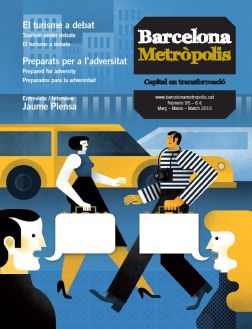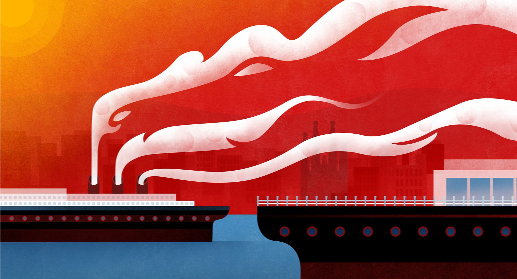Tourism, at the time it appeared in the early 20th century, was conceived as a pretext to attract financial, cultural and symbolic wealth. Tourism became part of Barcelona’s sense of self, its cultural identity and its political aspirations. This was the dream of a Greater Barcelona.
In the early 20th century the tourism boom came about as part of a cycle of cause and effect. This was derived from an intense process of political, economic, social, cultural and urban development that brought significant changes to Barcelona. The architect Ignasi de Solà-Morales, in an article published in 1994 (“Los locos arquitectos de una ciudad sonada”, Spanish for “The Mad Architects of a Dream City”) said it was in that turn-of-the-century Barcelona that de facto bodies found an ideal place in which to see their plans through. The emergence of tourism occurred at this point in time, at this juncture of changes and newly founded benchmarks. Tourism also flourished in line with a process of internationalisation dating back to the 1888 World Fair, when the push to place the Catalan capital on the map of major European cities got its start. This initiative would position the city in a market where it could capitalise on its new image and environment. Above all, however, it would also enable new networks for trade to be established and for the industrial base of Catalonia and Barcelona to be expanded. Only by considering these factors can we understand the beginnings of tourism in Barcelona, and hence how the interests linked to its promotion were the same ones that support today’s tourism.
Over the decades, tourism has been seen as an important factor for the city’s development. And although the planning, control and management of tourism have rarely been carried out from the political and governmental spheres, the development of Barcelona’s tourist industry has not been a spontaneous, coincidental or accidental phenomenon. It is part of a patently deliberate process.

Poster from the 1909 tourism campaign “Barcelona ciudad de invierno” [“Barcelona, a city for wintertime”], by Carlos Verger. The original is in the Museu Nacional d’Art de Catalunya.
It all started in March 1906 with the founding of the Commission to Attract Foreigners, the first municipal institution dedicated to the promotion of tourism in Barcelona. It was headed by four councillors (two regionalists: Lluís Duran i Ventosa and Joan Rubió; and two Republicans: Josep Rogent Pedrosa and Santiago Valentí Camp) and a mayor (Catholic and monarchist): Domènec Sanllehy.
The Commission remained active for a brief period of just three years, and its impact was rather modest. Nonetheless, it made at least four undeniable contributions of particular significance and noteworthy symbolic value. The first was the opening of the city’s first tourist information bureau in 1909, on the ground floor of the City Hall, and the creation of the role of municipal cicerone.
Secondly, the Commission launched a vast network of international relations (with consulates, tourist bureaus, passenger ship companies and journalists) and internal alliances designed to unite efforts in the field of tourism. The third contribution was of particular significance: the creation and promotion of the city’s first tourism image campaign. The latter contribution is of radical importance as it embodied the values of a city that did not exist at that time outside the realms of imagination and desire. The image alluded to a myth, an ideal of the way the city should be, not the way it really was. Through the prolific publishing of guides, albums and posters, the Commission shaped an image of Barcelona that evoked the ideals of order and culture, civic and aesthetic values that were connected with the Noucentisme movement of that time.
References to nature, Mediterranean culture, civility and progress were essential assets of the city’s first tourist image promoted by the Commission. The body dispensed with iconic images in favour of one with little figurative value, one that was absolutely idyllic and imbued with classicism (and classism). An image ultimately aimed at well-heeled tourists whose presence would help modernise Barcelona society. Thus, as was to be expected:
“Barcelona wishes to attract a high number of travellers who seek better weather, or simply the pleasant experiences that come with a change in ambience and perspective. It is not just for the sake of the material benefits brought by an industry aimed at attracting foreigners – a source of incalculable wealth from a range of locations in Switzerland, Italy and France – but, perhaps more importantly, the constant contact with people from different origins whose ways of thinking, aspirations and concepts of living are different. This will help us refine our social existence, guide the vigorous soul of our beloved city on an upward course and make it a true Mediterranean capital.”
In 1909 the city’s first tourism poster, the work of the Englishman Hassall, was published. It bore the motto “Barcelona, ciudad de invierno” (Spanish for “Barcelona, a city for wintertime”). This poster circulated around the world for decades and contributed to a trend that turned urban landscapes into new places for consumption and contemplation.
The Commission’s fourth contribution was no less significant and important than the previous ones. It laid the foundations for a correlation that would flourish over the years: linking the defence of tourism with patriotism, with a love of the city. The Commission developed a line of political action that was imbued with urban, economic, cultural and symbolic ideals and plans that suited the elite society of the time. Tourism was a necessary mechanism for economic, cultural and civic transformation. Barcelona’s tourism industry was born of a Noucentista city with the aim of benefiting a Noucentista city.
The Society to Attract Foreigners, comprising of representatives from the public and private spheres of Catalan and Barcelona society, was the body that replaced and intensified all the objectives and actions undertaken by the Commission. It existed from 1908 to 1936 and contributed immensely to the creation and promotion of the city’s tourism image.
It also helped foster a powerful hegemonic discourse about tourism, one that encouraged the creation and adaptation of tourist services and attractions as well as incentivising efforts to attract visitors. The Society also created a vast network of local and international connections. The industrial sector was firmly committed to this project. Proof of this is the fact that this sector funded a significant portion of the Society’s advertising material, which it also used for its own self-promotion.






Pingback: Quo Vadis Barcelona? | Núvol
Muy interesante